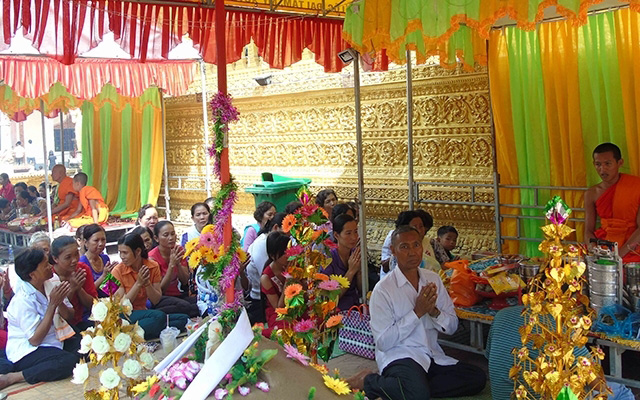


|
|
|
|
The joy for bumper season
There are around 1.2 million Khmer people living in the nearly
10 Mekong River Delta provinces and cities. Soc Trang has the most people
with over 400,000, accounting for nearly 31% of the population, distributed
equally in all districts, towns and cities.
These days, all the roads from the city to the countryside are
vibrant with colourful flowers and flags.
Thach Thi Dung from Tra Quyt B hamlet, Thuan Hoa commune said:
"This year, my family enjoyed a more prosperous Tet holiday thanks to better
farming. Previously, my family was poor without fields. However, after
receiving loans from the State to raise cows and then being trained in
breeding techniques by the local agricultural officials, we escaped from
poverty”. Since her family’s economy has improved, Dung has actively
participated in the activities of the local Women’s Union, appointed as a
coordinator of the policy credit fund and became an exemplary Party member.
In Vinh Chau town, Soc Trang province, where Khmer people
account for over 52% of the local population, the ethnic people’s lives have
changed rapidly. The transportation system in the locality is essentially
complete, while a medical station, schools, electricity and clean water have
been provided to serve locals. At present, the shrimp farming areas in Vinh
Chau are preparing for the main crop of this year. Kim Sa Rich from Pray Chop
hamlet, Lai Hoa commune, excitedly said: "Thanks to the State’s investment in
infrastructure, water resources have been ensured for shrimp farming areas.
Moreover, I can borrow capital and trained in farming techniques, so I
applied multi-cultivation model for more than 10,000 square metres of land,
gaining annual profit of over VND200 million. This year’s Chol Chnam Thmay is
more prosperous than previous years.”
In Tra Vinh province, the Khmer ethnic community accounts for
32% of the population. Nhue Tu B hamlet in Ham Giang commune was one of the
poorest areas in Tra Cu district in the past. However, thanks to the Party’s
leadership and State’s investment, Khmer people in the locality have
developed a more efficient agricultural economy. The arid fields are now
covered with the green colour of taro and pumpkins.
Villager Chau Sa Da Mol from Vinh Trung commune, Tinh Bien
district, An Giang province, shared that, this year, Khmer people enjoyed a
happier Chol Chnam Thmay thanks to the recent bumper rice crop. "Chol Chnam
Thmay Festival is an opportunity for family members and relatives to gather
and pay tribute to their ancestors”.
Development of homeland
All roads, particularly areas near Khmer pagodas, were decorated
prominently by flowers and flags to celebrate the Chol Chnam Thmay Tet
Festival.
Localities like Dai An commune (Tra Cu district, Tra Vinh
province), where Khmer people are the majority of the population, have seen
positive changes in their images and locals’ living standard.
In 2018, Soc Trang province effectively utilised the resources
of investment for the development of the ethnic minority community. As a
result, the ethnic people’s lives have seen significant improvement,
contributing to rapidly reducing the number of poor households. Head of the
provincial Ethnic Department Ly Binh Cang said that 11,440 households escaped
from poverty last year.
The campaign "All People Unite to Build New-Style Rural Areas
and Civilised Urban Areas” has brought about new appearances for many
localities, particularly regions with Khmer people. Venerable Ly Duc, deputy
head of Soc Trang province’s Association of united patriotic monks and nuns,
said that the province has 130 worshiping facilities, including 92 pagodas
and 38 salatels. So far, over 85% of pagodas have been renovated. There are
65 cultural spots at Khmer pagodas, including two recognised as a national
cultural and historical relic sites. Traditional religious activities and
cultural festivals have been maintained, contributing to preserving the
national cultural identities and improving the spiritual lives of monks and
Khmer Buddhists in the province.
According to Secretary of Soc Trang provincial Party Committee,
Phan Van Sau, the socio-economic situation of the Khmer ethnic minority
community has reached significant growth. The national cultural identities
have been preserved and promoted, while the political system has been
increasingly consolidated and developed and the great unity block of ethnic
groups has been promoted. Khmer people’s material and spiritual lives have
been constantly improved and their intellectual level has been raised. The
essential facilities for ethnic minority groups and disadvantaged communes
have received investment. He also noted: "The achieved results show the
efforts made by the entire Party committee, government and people in the
province, including Khmer people, in actively grasping opportunities and
effectively exploiting the localities’ potential and strength to develop the
set political, economic and social goals”.
|
Source: NDO